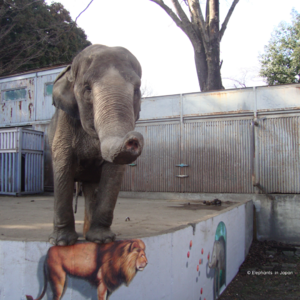Miyako (elephant): Difference between revisions
m (→See also) |
|||
| (2 intermediate revisions by 2 users not shown) | |||
| Line 21: | Line 21: | ||
== See also == | == See also == | ||
*[[Interview: Elephants in Japan]] | |||
*[[List of captive elephants]] | *[[List of captive elephants]] | ||
* [[Effects of captivity on elephants]] | * [[Effects of captivity on elephants]] | ||
* | * {{See also/elephant}} | ||
== External links == | == External links == | ||
Latest revision as of 10:34, 5 February 2024
 Miyako in her outdated enclosure at the Utsunomiya Zoo in Japan. Image: Elephants in Japan | |
| Species | Asian elephant (Elephas maximus) |
|---|---|
| Sex | Female |
| Born | 1973 Thailand |
| Capture age | 6 months |
Miyako is a female Asian elephant who lives in Utsunomiya Zoo in Japan. She is the only elephant in the zoo and has been living there since 1974. She was born in Thailand in 1971 and was captured from the wild when she was about two years old.
Controversy
Miyako’s welfare has been a subject of controversy and criticism from animal rights activists and elephant experts. They claim that Miyako suffers from poor living conditions, lack of social interaction, inadequate veterinary care, and deteriorating health. Some of the issues raised by the critics include:
- Miyako’s enclosure is too small, barren, and concrete-floored, which causes stress, boredom, and foot problems for her.
- Miyako has no access to a proper pool, which is essential for elephants to cool down, exercise, and relieve pressure on their feet.
- Miyako has no companions of her own species, which is detrimental to her mental and emotional well-being. Elephants are highly social animals that need to form bonds with other elephants.
- Miyako has not received proper foot care, which has resulted in overgrown nails, poor cuticles, and potential swelling. Foot problems are a leading cause of death for captive elephants.
- Miyako shows signs of physical and psychological distress, such as tiredness, standing naps, stiff and sore joints, and demonstrative behavior. She also appears to have lost weight and energy over the years.
Advocacy
Several organizations and individuals have been advocating for Miyako’s welfare and calling for her relocation to a more suitable facility. One of them is Elephants in Japan, a group that campaigns for the ethical treatment of captive elephants in Japan. Elephants in Japan has been reaching out to Utsunomiya Zoo and its owner since 2018, offering to provide expert assistance and medical care for Miyako. However, the zoo has not responded to Elephants in Japan’s requests or engaged in any dialogue with them.
Elephants in Japan has also launched an online petition to urge the zoo to improve Miyako’s living conditions and allow her to be assessed by experienced elephant specialists. The petition has gathered over 200,000 signatures from people around the world.
Elephants in Japan is not the only group that has expressed concern about Miyako’s situation. In 2017, elephant biologist Dr. Keith Lindsay visited Miyako and documented his findings in a report titled "Solitary Elephants in Japan". The report highlighted the poor conditions and care provision at Utsunomiya Zoo and recommended urgent action to improve Miyako’s welfare. Dr. Lindsay also revisited Miyako in 2023 and noted a significant and startling decline in her health.
Other experts who have commented on Miyako’s case include Dr. Joyce Poole, co-founder of ElephantVoices, who said that Miyako’s life is “a tragedy” and that she deserves better; and Dr. Cynthia Moss, founder of Amboseli Trust for Elephants, who said that Miyako’s situation is “heartbreaking” and that she needs companionship and space.
See also
- Interview: Elephants in Japan
- List of captive elephants
- Effects of captivity on elephants
- Elephant Portal
- Elephant (interviews)
- Elephant (news)
- Elephant (research)
- Elephant (videos)
External links
- Miyako Elephants in Japan
- Elephant Miyako living alone for 49 years in Japan The Animal Reader Archived Jun 5, 2023
- Interview - elephant Miyako living alone for 49 years at Japanese zoo YouTube
- AN URGENT UPDATE: MIYAKO THE SOLITARY CAPTIVE ELEPHANT Elephants in Japan
